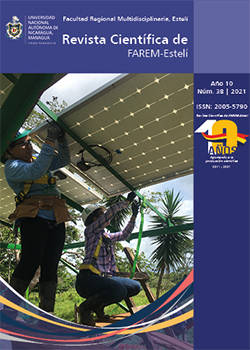Evolution of temperature and precipitation in four meteorological stations, located in the north-central region of Nicaragua, Central America
DOI:
https://doi.org/10.5377/farem.v0i38.11952Keywords:
Dry corridor, water deficit, evapotranspiration, temperature, precipitationAbstract
Temperature and precipitation are the main indicator variables of climate change, a consequence of global change. The behavior of precipitation and temperature data in four meteorological stations located in the North Central part of Nicaragua, in a period of 10 years (2009 to 2019) is evaluated. The data correspond to the stations: Raul Gonzales, El Limon, Condega and Ocotal. From the temperature and precipitation variables, evapotranspiration was estimated by the Penman-Monteith method and the water deficit. The results show that the Raúl González station recorded average annual temperatures of 25.3°C, Condega 24.6°C, Ocotal 24.5°C and El Limón 23.1°C. On the other hand, the average annual precipitations correspond to: 1005mm, 939 mm, 892 mm and 889 mm for the Condega, Raul Gonzalez, El Limon and Ocotal stations respectively. The evapotranspiration for the Raul Gonzalez station is 1381 mm, Ocotal 1375 mm, Condega 1361 mm and El Limon 1272 mm. In other words, evapotranspiration was higher in most years, indicating a water deficit. The behavior of the temperatures and precipitation studied may be due to the El Niño Southern Oscillation (ENSO) phenomenon, as well as tropical storms and depressions.
Downloads
714
HTML (Español (España)) 406
Published
How to Cite
Issue
Section
License
Copyright (c) 2021 Revista Científica de la FAREM-Estelí

This work is licensed under a Creative Commons Attribution-NonCommercial-ShareAlike 4.0 International License.
© Revista Científica de FAREM-Estelí

